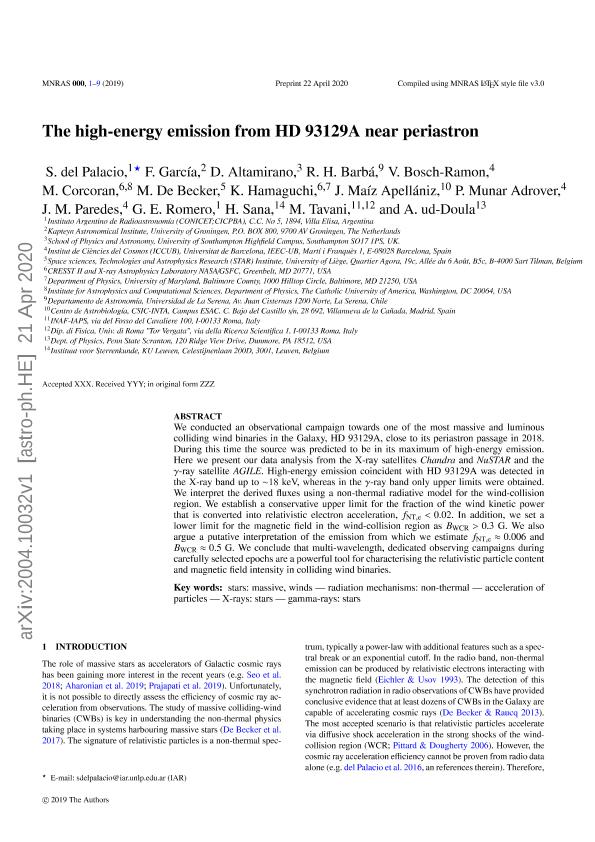Artículo
The high-energy emission from HD 93129A near periastron
del Palacio, Santiago ; García, Federico
; García, Federico ; Altamirano, D.; Barba, Rodolfo Hector
; Altamirano, D.; Barba, Rodolfo Hector ; Bosch Ramon, Valentí; Corcoran, Michael; De Becker, M.; Hamaguchi, K.; Maíz Apellániz, Jesús; Munar Adrover, P.; Paredes, Josep Maria; Romero, Gustavo Esteban
; Bosch Ramon, Valentí; Corcoran, Michael; De Becker, M.; Hamaguchi, K.; Maíz Apellániz, Jesús; Munar Adrover, P.; Paredes, Josep Maria; Romero, Gustavo Esteban ; Sana, H.; Tavani, M.; ud-Doula, A.
; Sana, H.; Tavani, M.; ud-Doula, A.
 ; García, Federico
; García, Federico ; Altamirano, D.; Barba, Rodolfo Hector
; Altamirano, D.; Barba, Rodolfo Hector ; Bosch Ramon, Valentí; Corcoran, Michael; De Becker, M.; Hamaguchi, K.; Maíz Apellániz, Jesús; Munar Adrover, P.; Paredes, Josep Maria; Romero, Gustavo Esteban
; Bosch Ramon, Valentí; Corcoran, Michael; De Becker, M.; Hamaguchi, K.; Maíz Apellániz, Jesús; Munar Adrover, P.; Paredes, Josep Maria; Romero, Gustavo Esteban ; Sana, H.; Tavani, M.; ud-Doula, A.
; Sana, H.; Tavani, M.; ud-Doula, A.
Fecha de publicación:
06/2020
Editorial:
Wiley Blackwell Publishing, Inc
Revista:
Monthly Notices of the Royal Astronomical Society
ISSN:
0035-8711
Idioma:
Inglés
Tipo de recurso:
Artículo publicado
Clasificación temática:
Resumen
We conducted an observational campaign towards one of the most massive and luminous colliding wind binaries in the Galaxy, HD 93129A, close to its periastron passage in 2018. During this time the source was predicted to be in its maximum of high-energy emission. Here we present our data analysis from the X-ray satellites Chandra and NuSTAR and the γ-ray satellite AGILE. High-energy emission coincident with HD 93129A was detected in the X-ray band up to ∼18 keV, whereas in the γ-ray band only upper limits were obtained. We interpret the derived fluxes using a non-thermal radiative model for the wind-collision region. We establish a conservative upper limit for the fraction of the wind kinetic power that is converted into relativistic electron acceleration, fNT,e < 0.02. In addition, we set a lower limit for the magnetic field in the wind-collision region as BWCR > 0.3 G. We also argue a putative interpretation of the emission from which we estimate fNT,e ≍ 0.006 and BWCR ≍ 0.5 G. We conclude that multiwavelength, dedicated observing campaigns during carefully selected epochs are a powerful tool for characterizing the relativistic particle content and magnetic field intensity in colliding wind binaries.
Archivos asociados
Licencia
Identificadores
Colecciones
Articulos(IAR)
Articulos de INST.ARG.DE RADIOASTRONOMIA (I)
Articulos de INST.ARG.DE RADIOASTRONOMIA (I)
Citación
del Palacio, Santiago; García, Federico; Altamirano, D.; Barba, Rodolfo Hector; Bosch Ramon, Valentí; et al.; The high-energy emission from HD 93129A near periastron; Wiley Blackwell Publishing, Inc; Monthly Notices of the Royal Astronomical Society; 494; 4; 6-2020; 6043-6052
Compartir
Altmétricas



